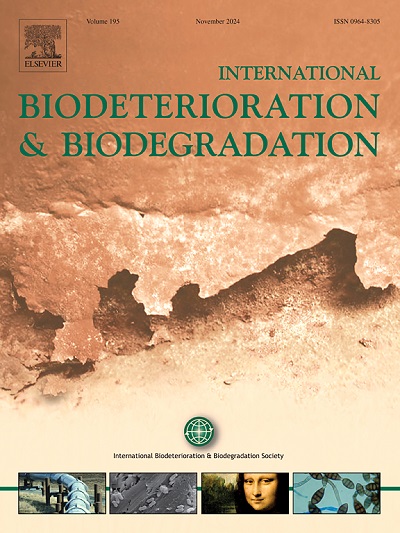Unravelling OTA-detoxification by the dioxin-mineralizing bacterium Rhizorhabdus wittichii RW1T
IF 4.1
2区 环境科学与生态学
Q2 BIOTECHNOLOGY & APPLIED MICROBIOLOGY
International Biodeterioration & Biodegradation
Pub Date : 2025-06-01
DOI:10.1016/j.ibiod.2025.106131
引用次数: 0
Abstract
Environmental pollution remains a critical concern for public health, necessitating innovative remediation strategies. In this regard, microorganisms play a pivotal role by naturally degrading and eliminating various pollutants. The Rhizorhabdus wittichii RW1T strain is recognized for its ability to metabolize a broad spectrum of toxic and persistent environmental contaminants. Given the relevance of ochratoxin A (OTA) as a harmful mycotoxin affecting agricultural settings, this study investigates the capability of R. wittichii RW1T (DSM 6014T) in neutralizing OTA. Experimental results demonstrate that this strain effectively breaks down OTA by hydrolyzing its amide bond, leading to the production of ochratoxin α and L-β-phenylalanine, both of which are non-toxic. Computational genome analysis of R. wittichii RW1T revealed genes encoding proteins homologous to known OTA-degrading amidohydrolases. This investigation identified a 438-amino acid protein (ABQ67280.1), whose recombinant form (RwOTA) efficiently hydrolyzes OTA and ochratoxin B through a catalytic mechanism involving a binuclear metal center. This center facilitates the polarization of the carbonyl group of the scissile amide bond of OTA and activates a water molecule for hydrolysis. Screening against a synthetic peptidase substrate library indicated a highly specific hydrolytic activity for RwOTA. Structural modeling and molecular docking simulations provided insights into the interaction of ochratoxins with RwOTA, shedding light on its substrate specificity. The gene encoding RwOTA presents a promising addition to the extensive repertoire of biodegradation-associated genes within R. wittichii RW1T, reinforcing its potential in environmental pollutant detoxification.

二恶英矿化细菌威氏根瘤菌RW1T解毒的研究
环境污染仍然是公众健康的一个严重问题,因此需要创新的补救战略。在这方面,微生物通过自然降解和消除各种污染物发挥着关键作用。威氏根腐菌RW1T菌株因其代谢广谱有毒和持久性环境污染物的能力而得到认可。考虑到赭曲霉毒素A (OTA)作为一种影响农业环境的有害真菌毒素的相关性,本研究调查了威氏赭曲霉RW1T (DSM 6014T)中和OTA的能力。实验结果表明,该菌株通过水解OTA的酰胺键,有效分解OTA,生成赭曲霉毒素α和L-β-苯丙氨酸,两者均无毒。计算基因组分析揭示了与已知的羟色胺降解酶同源的蛋白质编码基因。本研究鉴定了一个含有438个氨基酸的重组蛋白(ABQ67280.1),其重组形式(RwOTA)通过涉及双核金属中心的催化机制高效水解OTA和赭曲霉毒素B。该中心促进了OTA的可剪酰胺键羰基的极化,并激活水分子进行水解。对合成肽酶底物文库的筛选表明,RwOTA具有高度特异性的水解活性。结构建模和分子对接模拟揭示了赭曲霉毒素与RwOTA的相互作用,揭示了其底物特异性。编码RwOTA的基因是wittichii RW1T中生物降解相关基因的一个有希望的补充,增强了其在环境污染物解毒方面的潜力。
本文章由计算机程序翻译,如有差异,请以英文原文为准。
求助全文
约1分钟内获得全文
求助全文
来源期刊
CiteScore
9.60
自引率
10.40%
发文量
107
审稿时长
21 days
期刊介绍:
International Biodeterioration and Biodegradation publishes original research papers and reviews on the biological causes of deterioration or degradation.

 求助内容:
求助内容: 应助结果提醒方式:
应助结果提醒方式:


